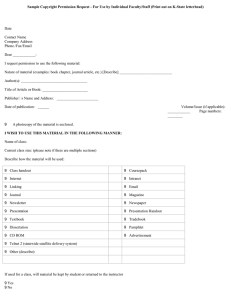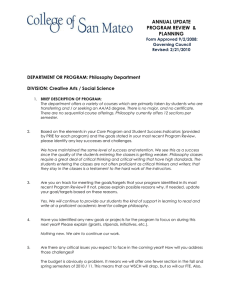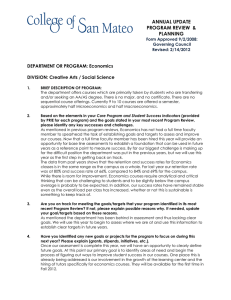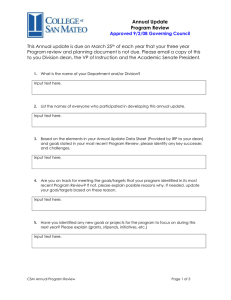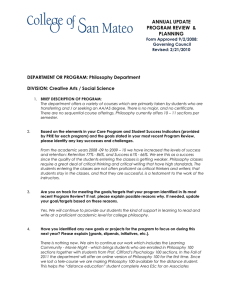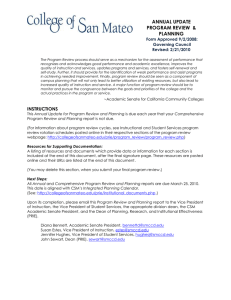DEPARTMENT OR PROGRAM:
advertisement
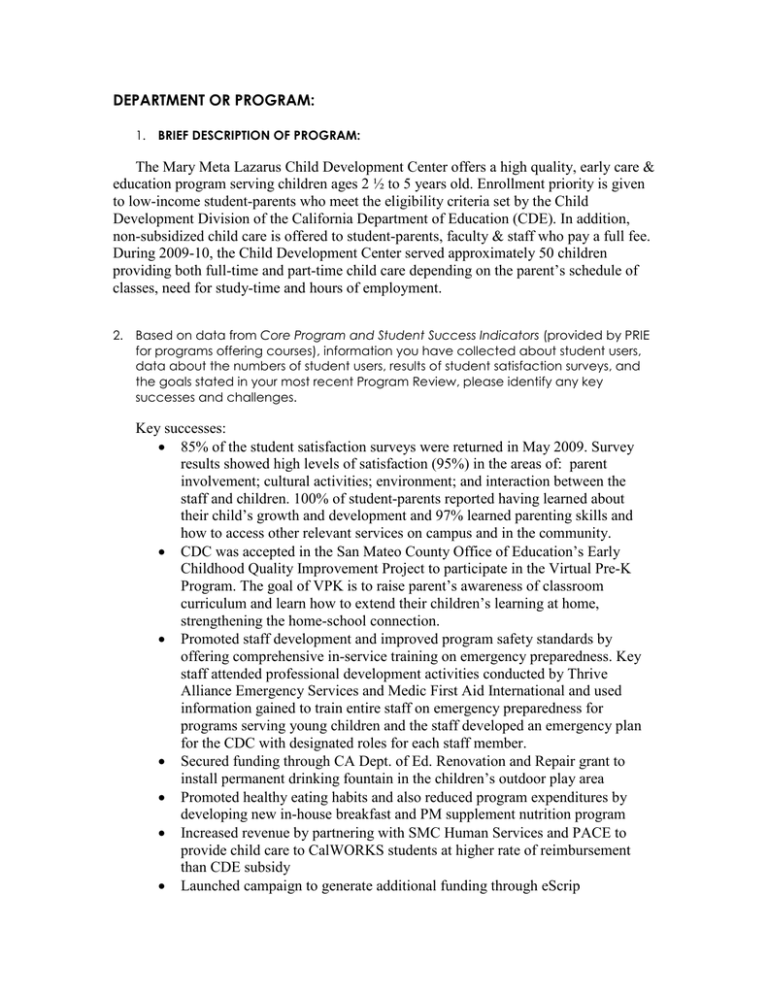
DEPARTMENT OR PROGRAM: 1. BRIEF DESCRIPTION OF PROGRAM: The Mary Meta Lazarus Child Development Center offers a high quality, early care & education program serving children ages 2 ½ to 5 years old. Enrollment priority is given to low-income student-parents who meet the eligibility criteria set by the Child Development Division of the California Department of Education (CDE). In addition, non-subsidized child care is offered to student-parents, faculty & staff who pay a full fee. During 2009-10, the Child Development Center served approximately 50 children providing both full-time and part-time child care depending on the parent’s schedule of classes, need for study-time and hours of employment. 2. Based on data from Core Program and Student Success Indicators (provided by PRIE for programs offering courses), information you have collected about student users, data about the numbers of student users, results of student satisfaction surveys, and the goals stated in your most recent Program Review, please identify any key successes and challenges. Key successes: • 85% of the student satisfaction surveys were returned in May 2009. Survey results showed high levels of satisfaction (95%) in the areas of: parent involvement; cultural activities; environment; and interaction between the staff and children. 100% of student-parents reported having learned about their child’s growth and development and 97% learned parenting skills and how to access other relevant services on campus and in the community. • CDC was accepted in the San Mateo County Office of Education’s Early Childhood Quality Improvement Project to participate in the Virtual Pre-K Program. The goal of VPK is to raise parent’s awareness of classroom curriculum and learn how to extend their children’s learning at home, strengthening the home-school connection. • Promoted staff development and improved program safety standards by offering comprehensive in-service training on emergency preparedness. Key staff attended professional development activities conducted by Thrive Alliance Emergency Services and Medic First Aid International and used information gained to train entire staff on emergency preparedness for programs serving young children and the staff developed an emergency plan for the CDC with designated roles for each staff member. • Secured funding through CA Dept. of Ed. Renovation and Repair grant to install permanent drinking fountain in the children’s outdoor play area • Promoted healthy eating habits and also reduced program expenditures by developing new in-house breakfast and PM supplement nutrition program • Increased revenue by partnering with SMC Human Services and PACE to provide child care to CalWORKS students at higher rate of reimbursement than CDE subsidy • Launched campaign to generate additional funding through eScrip Key challenges: • • • 2. Results of student satisfaction surveys showed 10% of parents did not gain information on how to help their child learn at home and did not learn how children develop at different ages Teacher position remains vacant due to budget constraints, reliance on part-time student assistants to maintain staff/child ratios does not ensure consistent staffing on a daily basis, 1 additional position (Office Assistant II) is also now vacant Program self-evaluation using ECERS instrument demonstrated a rating of inadequate/minimal on subscale “space for gross motor development” because of safety hazards due to insufficient surfacing material around fall zone of climbing structure Are you on track for meeting the goals/targets that your program identified in its most recent Program Review? If not, please explain possible reasons why. If needed, update your goal/targets based on these reasons. All goals identified in March 2009 Program Review have been met. Have you identified any new goals or projects for the program to focus on during this next year? Please explain (grants, stipends, initiatives, etc.). • Comply with playground safety requirements by installing sufficient surfacing material on playground • Foster children’s early literacy and school readiness skills through innovative curriculum development • Develop parenting program on Kindergarten preparedness • Design early intervention process to identify children w/ special needs • Broaden family centered practices to include translation of program materials for parents in home language 5. Are there any critical issues you expect to face in the coming year? How will you address those challenges? Critical Issue: generating additional funding to supplement loss of Lazarus endowment and further reduce Fund 1 contribution to the program Strategies to address budget challenge: organize fund-raising projects to generate additional revenue; develop alumni appeal campaign; seek external funding through grants and private donations; continue building eScrip program; and increase tuition fees for non-subsidized parents 6. STUDENT LEARNING OUTCOMES (SLOs) AND ASSESSMENT FOCUS FOR THIS YEAR: a. Identify at least one course SLO on which to focus. Describe the assessment strategies you will use and your method of reflection and documentation for this cycle. SLO for 2009-10: Parents will support their child’s learning by becoming active participants in their child’s education and by reinforcing their child’s learning at home. Assessment strategies include a pre-test administered in November 2009 and a post-test to be administered in May 2010. Test scores will be compared and data analyzed to determine if parents learned how to reinforce their child’s learning at home as a result of participating in the VPK program. In addition, assessment data collected by 1st 5 San Mateo County on Virtual Pre-K participants will be used as a second measure of parent’s learning as it relates to supporting their child’s education at home. The data collected will be used to improve the family involvement program. 7. SUMMARY OF RESOURCES NEEDED TO REACH PROGRAM ACTION STEPS (Data resources: Educational Master Plan, 2008; Institutional Priorities, 2008-2011; College Index, 2009-2010; GE-SLOs, SLOs; department and program records; Core Program and Student Success Indicators; previous Program Review and Planning reports; other data) a. In the matrices below, itemize the resources needed to reach program action steps and describe the expected outcomes for program improvement.* Specifically, describe the potential outcomes of receiving these resources and the programmatic impact if the requested resources cannot be granted. *Note: Whenever possible, requests should stem from assessment of SLOs and the resulting program changes or plans. Ideally, SLOs are assessed, the assessments lead to planning, and the resources requested link directly to those plans. Full-Time Faculty Positions Requested (if applicable) Expected Outcomes if Granted and Expected Impact if Not Granted Input text here. Input text here. Classified Positions Requested Expected Outcomes if Granted and Expected Impact if Not Granted Input text here. Input text here. If applicable, briefly indicate how the requested resources will link to achieving department action steps based on SLO assessment. Input text here. If applicable, briefly indicate how the requested resources will link to achieving department action steps based on SLO assessment. Input text here. b. For instructional resources or program resources including equipment and materials, please list the exact items you want to acquire and the total costs, including tax, shipping, and handling. Include items used (such as computers and furniture) and all materials designed for use by students and staff as resources (such as lab equipment, books, CDs, technology-based materials, educational software, tests, non-printed materials, etc). Add rows to the tables as necessary. If you have questions as to the specificity required, please consult with your dean. Please list by priority. Resources Requested Item: input text here Number: input text here Vendor: Input text here. Unit price: Input text here. Total Cost: Input text here. Status*: Input text here. Expected Outcomes if Granted and Expected Impact if Not Granted input text here *Status = New, Upgrade, Replacement, Maintenance or Repair. If applicable, briefly indicate how the requested resources will link to achieving department action steps based on SLO assessment. Input text here. 8. PROGRAM REVIEW PARTICIPANTS AND SIGNATURES Date of this Annual Update for Program Review and Planning evaluation: Please list the department’s Annual Update for Program Review and Planning report team as appropriate: Primary program contact person: Louise Piper Phone and email address: (650) 574-6279 Full-time faculty: Louise Piper Part-time faculty: Administrators: Classified staff: Karen Wiggins Dowler, Maggie Lam, Lori Pilster, Yovanka Crossley, Clara Vladez Chon, Jamie Hui Students: Louise Piper Primary Program Contact Person’s Signature 3/25/10 Date Full-time Faculty’s Signature Part-time Faculty’s Signature Administrator’s Signature Classified Staff Person’s Signature Student’s Signature Dean’s Signature Date (as appropriate) (as appropriate) (as appropriate) (as appropriate) Date Date Date Date Date
